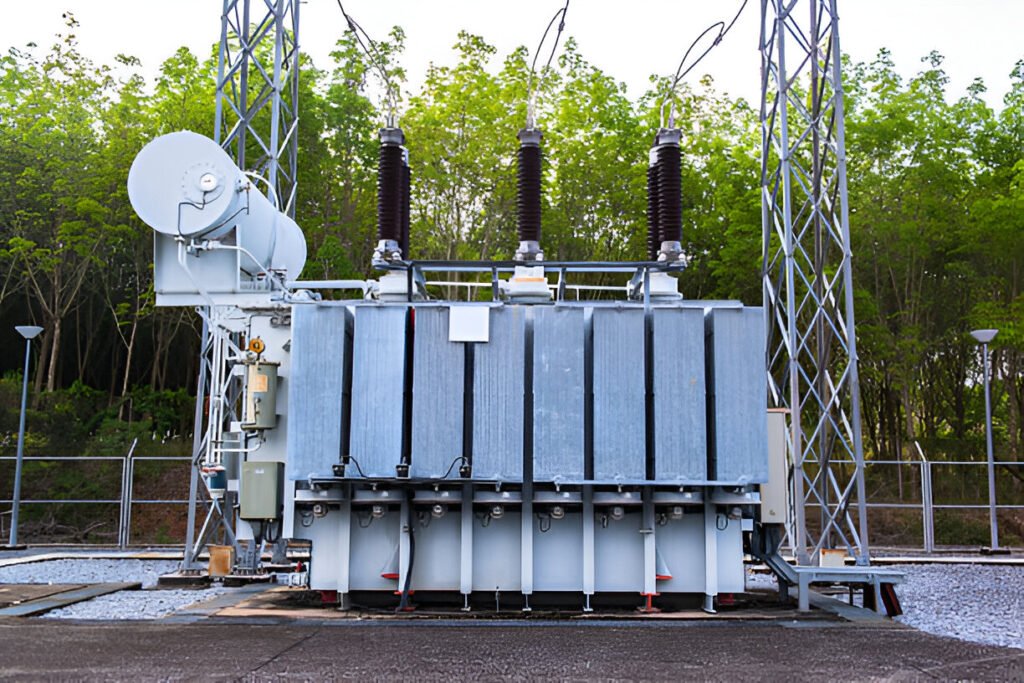What Is the Difference Between a Power Transformer and a Voltage Transformer
Power transformers transfer electrical power and provide isolation, while voltage transformers specifically change AC voltage levels.
Read More
A delta wye transformer, also known as a delta-star transformer, is a type of three-phase transformer that combines the delta and wye (star) winding configurations. This transformer is designed to convert high-voltage delta-connected power to low-voltage wye-connected power, making it suitable for various industrial and commercial applications.
The delta wye configuration offers several advantages, including the elimination of third-harmonic currents, improved current balance on the primary side for unbalanced loads, and the ability to supply line-to-neutral single-phase loads.

A delta wye transformer, also known as a delta-star transformer, is a type of three-phase transformer that converts electrical power from a delta configuration on the primary side to a wye (or star) configuration on the secondary side. The delta connection is made by connecting the ends of each phase winding, forming a triangular shape, while the wye connection is made by connecting one end of each phase winding together at a common point, forming a “Y” shape.
The delta-wye transformer allows for the efficient transmission and distribution of electrical power across long distances. By using a delta connection on the primary side and a wye connection on the secondary side, the transformer can step down the voltage while maintaining a stable and balanced three-phase power supply.

One of the primary applications is in power distribution systems, where these transformers can step down high-voltage transmission to lower voltages suitable for end-users. The delta-wye configuration allows for the supply of both three-phase and single-phase loads, making it a versatile choice for diverse electrical requirements.
In industrial facilities, delta-wye transformers are commonly employed to power large motors, drives, and other heavy machinery. The delta primary winding effectively eliminates third-harmonic currents, preventing their circulation in the supply line and reducing harmonic distortion.
Another key application of delta-wye transformers is in commercial buildings, such as office complexes, hospitals, and shopping centers. These transformers provide a reliable and efficient means of distributing power to various loads, including lighting systems, HVAC equipment, and electronic devices. The neutral wire in the wye secondary enables the supply of line-to-neutral single-phase loads, ensuring compatibility with a wide range of electrical equipment.
Moreover, delta-wye transformers are essential in renewable energy systems, particularly in wind and solar power plants. These transformers help integrate the generated electricity into the main grid by stepping up the voltage from the renewable sources to match the transmission line requirements. The delta-wye configuration offers better current balance on the primary side, even when the secondary loads are unbalanced, ensuring stable and efficient power transfer.

| Characteristic | Delta-Wye | Delta-Delta | Wye-Wye | Wye-Delta |
|---|---|---|---|---|
| Phase shift | 30° lag | No phase shift | No phase shift | 30° lead |
| Neutral point | Available on wye side | Not available | Available on both sides | Available on wye side |
| Grounding | Neutral can be grounded | No neutral for grounding | Neutral can be grounded on both sides | Neutral can be grounded on wye side |
| Third harmonic suppression | Yes, on wye side | No | No | Yes, on delta side |
| Voltage transformation ratio | 1:√3 (delta:wye) | 1:1 | 1:1 | √3:1 (wye:delta) |
| Application | Used for step-up and step-down, allows grounding on secondary | Used for step-up and step-down, no grounding | Used for step-up and step-down, allows grounding on both sides | Used for step-up, allows grounding on primary |
| Fault current | High on delta side, low on wye side | High on both sides | Low on both sides | Low on wye side, high on delta side |
| Cost | Higher due to asymmetrical design | Lower due to symmetrical design | Lower due to symmetrical design | Higher due to asymmetrical design |
| Unbalanced load handling | Good, due to neutral point | Poor, no neutral point | Good, due to neutral points | Moderate, due to one neutral point |
A delta wye transformer is used to convert three-phase power from a delta configuration to a wye (star) configuration or vice versa, allowing for voltage transformation and isolation between the primary and secondary windings.
In a delta wye transformer, the secondary line-to-line voltage is equal to the primary phase voltage multiplied by the turns ratio. The secondary line-to-neutral voltage is the secondary line-to-line voltage divided by √3.
Yes, delta wye transformers can be used for both step-up and step-down applications, depending on the turns ratio between the primary and secondary windings.
In a delta wye transformer, there is a 30-degree phase shift between the primary line-to-line voltages and the secondary line-to-neutral voltages.
The neutral point in a wye-connected secondary allows for the supply of single-phase loads and provides a reference point for the phase voltages. Grounding the neutral point helps stabilize the voltage and provides a path for fault currents.
In a balanced three-phase system, the load currents on the secondary side of a delta wye transformer will not affect the primary side. However, unbalanced loads can cause currents to flow in the primary delta winding, leading to increased losses and heating.